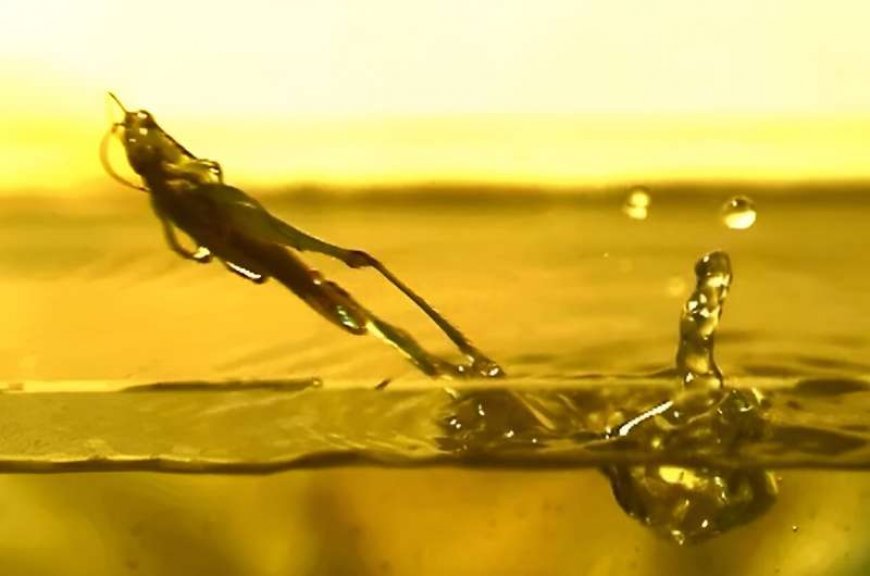New robot swims and jumps like a Chinese rice grasshopper
New robot swims and jumps like a Chinese rice grasshopper

Biologist, materials scientist and bionics specialist Professor Stanislav N. Gorb and his team at Kiel University's Institute of Zoology are known for analyzing the spectacular abilities of animals and translating them into innovative technical applications. For example, they created robot grab arms based on the model of insects and a detachable adhesive film that works in a similar manner to the adhesive organs of insects, spiders and geckos.
In a paper just published in the Proceedings of the National Academy of Sciences, Gorb examined the Chinese rice grasshopper Oxya chinensis in collaboration with researchers from China. "Their ability to swim and jump out of the water offers important inspiration for advanced robotics," explained the head of the Functional Morphology and Biomechanics working group.
The grasshopper's extremely fast locomotion on the water surface, especially the way it jumps in water, has been largely unresearched until now. "Our work not only revealed the combined mechanisms that are responsible for facilitating water acrobatics in this species, but also laid the foundations for the development of bioinspired robots that can move on varied terrain," said Gorb.
Water acrobatics through a combination of static and dynamic forces
The Chinese rice grasshopper is widespread in China's rice growing region, especially along the Yangtze River, and particularly adept at water acrobatics for a land animal. If they fall into the water, they can easily get out again and fly away.
How exactly they do that has been studied in detail in the laboratory. For the experiment, 15 grasshoppers (O. chinensis) with a body length (excluding legs) of 2.2 to 3.4 centimeters and a weight of 0.4 to 1.0 grams were thrown into a glass tank full of water. They either remained completely inactive on the surface of the water, passively drifted with the flow, actively swam or immediately jumped out.
"We filmed the grasshoppers, as they swam in the water tank or jumped out of it, using two high-speed cameras," said Gorb. A total of 48 attempts to jump and 54 attempts to swim by the animals were included in further analysis. The researchers compared the jumping and swimming locomotion and then analyzed the mechanisms used by the grasshoppers to generate forces that facilitate their water acrobatics
Force measurements and model analyses revealed that body weight support through hydrostatic pressure can be achieved proportional to the mass of the grasshoppers, while motion drives are derived from controlled interactions between limbs and water (i.e., hydrodynamics).
New drive strategy for robotics
Previous studies have concentrated primarily on two types of locomotion on the surface of the water: locomotion that is mainly supported by the surface tension, used, for example, by water striders, and locomotion that is dominated by the special dynamics of the limbs. This is used, for example, by basilisk lizards to run on water. Neither strategy is ideal for bioinspired technical applications.
"Locomotion dominated by the surface tension in water depends on superhydrophobic (not wettable) surfaces, which are not easy to achieve for large robots. And the aquatic locomotion dominated by the dynamics of the limbs is based on a frequent striking of the surface, both by animals as well as robots, which uses far too much energy," reported Gorb.
The ability of the Chinese rice grasshopper to jump out of the water is based on another drive principle that has been revealed now for the first time. "The grasshopper displayed a combination of two different mechanisms to facilitate their water acrobatics by supporting their weight through static hydro forces and moving their bodies forward through hydrodynamics."
After studying the structural and behavioral strategies of the grasshoppers, Gorb and his team built their first robot. Like the insects, the prototype can swim and jump on the surface of the water by moving its limbs at varying speeds.

 Phương Nhung
Phương Nhung 





